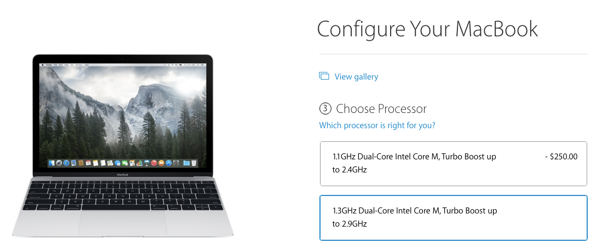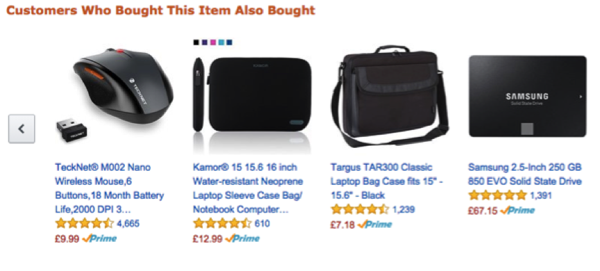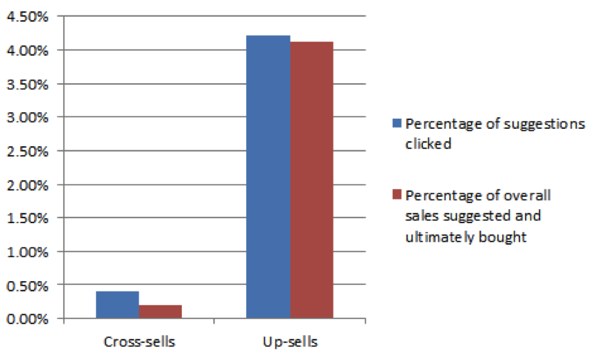How to increase revenue with up-selling and cross-selling
You’re probably putting a lot of effort into attracting visitors to your site and enticing them to buy your products and services. So when they’ve already shown intent to purchase, take advantage and introduce them to products better than, or complementary to, the ones they’re already interested in. Why? Because if you don’t you may be leaving revenue on the table.
In fact, did you know that product recommendations like upsells and cross-sells are responsible for an average of 10-30% of ecommerce revenues, according to Forrester research analyst Sucharita Mulpuru? Or that Amazon reported in 2006 that cross-selling and up-selling contributed as much as 35% of their revenue?
There’s no reason why product recommendations like up-sells and cross-sells shouldn’t work for you. So in this post we’ll look at why up-selling and cross-selling are so important and how to use them to get more value from your customers.
Let’s jump into it.
What is up-selling?
Up-selling is when you encourage customers to spend more by recommending a superior, higher priced alternative to one they already own or are considering purchasing. A superior alternative can be a better model of a product or the same product but with added features that raise its value.
Examples of an up-sell
- The well-known “Do you want chips with that?” used by McDonalds
- A customer purchasing a computer being up-sold additional software like more memory or extended warranty
- A nail salon that offers a discount when you spend a certain amount
What is cross-selling?
Cross-selling refers to recommending customers related products that complement their existing purchase. While you can grow your revenue by using this technique, the main focus should be to provide your customers with even greater benefit and advantage.
Examples of a cross-sell
- When booking a flight on a travel site and they also give you suggestions of hotels, rental cars, and other travel related services.
- When you buy a digital camera and you are also recommended to buy a camera case or a memory card
- When you are get a discount when buying multiple products at once (Amazon uses this technique very well)
What’s the difference between the two?
Up and cross-selling are often confused so to make things clearer let’s take a look at the difference between the two.
Say a visitor is looking to purchase a laptop.
Up-sell: After selecting it, the customer is immediately presented with several options for upgrading the processor. This is up-selling as the seller is trying to get the customer to spend more on the same product or product type that they’re looking at, but a more powerful (and expensive) version.
Here’s an example from the Apple store:
Cross-sell: After the customer selects the laptop they wish to purchase, they’re also recommended a mouse or a printer that they can add to their order. Since this accessory is related to the product they’re already interested in purchasing, it’s considered a cross-sell.
Here’s an example from Amazon:
A great thing about up and cross-selling is that you don’t need to be pushy. In fact, you should use these techniques to “help customers win” as illustrated beautifully in this video by Jeffrey Gittomer:
In other words, use these selling techniques to ensure that your customers are choosing the right product or service for them, and that they have everything they need to make the most of it.
Should you use these selling techniques?
Up and cross-selling work, and that’s because the customer has already made the most important decision: to buy.
Here are a few other reasons why should use up and cross-selling:
- To increase customer retention. Steve Jobs said that “people don’t know what they want until you show it to them”. So do that. Become their best friend and make recommendations to help them find a better product.
- To increase average order value and life-time value. According to a Marketing Metric study, the probability of selling to an existing customer is 60 – 70% while the probability of selling to a new prospect is 5-20%. So if you want to boost life-time value, you need to up and cross-sell.
Which is better: up-selling or cross-selling?
This is a common dilemma. You don’t want to overwhelm or bombard your customers, so which type of recommendations should you go with? Should you up-sell to show similar yet more powerful and expensive products, or should you cross-sell by suggesting complimentary items?
According to research from Predictive Intent 4% of customers convert on average through up-selling.
Research also shows that up-selling performs 20 times better than cross-selling when it comes to product pages.
Here are some suggestions on how to up-sell:
- Promote your top sold products
- Make them more prominent so customers can’t miss them. For example, you could also display testimonials next to the products.
- Make sure an up-sell is not more than 25% costlier than the original product that they intended to buy
- Give context to your suggestion by telling them exactly why they should go with your recommendation instead of their initially chosen product.
On the other hand, cross-selling was shown to be more effective when presented on the checkout page versus product pages. This is your chance to tap into impulse buying. There’s a reason checkout lanes are full of small-ticket items like sweets, chewing gum, lip balm, batteries, and other “essentials.” So use the checkout to recommend products that are easily forgotten such as: smartphone cases, earplugs, memory cards, rechargeable batteries, etc.
Actionable tips to ups-sell/cross-sell
While the goal of up-selling and cross-selling is to sell more products to each customer, try to focus more on the customer experience and on helping them choose the best items for their needs. When recommending alternative or extra items, your suggestions need to make sense and to be relevant to the item that they’re interested in purchasing. If your recommendations aren’t relevant, your conversions will suffer.
Here are a few things that you need to consider when promoting up-sell and cross-sell opportunities to your customers:
Don’t bombard them with too many choices. If they’ve already said no to an upsell product, don’t keep pushing. If you’re too aggressive, they might not make a purchase at all and you might lose them for good.
Show only items that make sense alongside the original item. Asking me if I’d like a cookie with my coffee is logical, adding value without a huge decision or price tag. But asking me if I want a website with my business cards is not.
Create a bundle of products or services. This way you can sell a bundle with three products instead of trying to up-sell three individual products. Customers love bundles. One transaction, fewer decisions, better price, more items.
Use social proof to suggest other products customers might be interested in. Amazon is a master at this as it recommends products based on what others who bought similar products also purchased. This is helpful as it tells you that other customers did it so they must have needed them, which means you will too.
Listen and don’t rush it. Don’t up or cross-sell until the end of a transaction when the customer is already decided on buying something in the first place. That would be like going to McDonalds and being offered chips before having the chance to order your primary meal.
Wrapping up
If you want up-selling and cross-selling to work for you, you first need to listen to your customers and understand exactly what it is that they want and need. Only then can you make recommendations and offer products and services that can help move them toward their goal. Amazon is the proof that when done authentically, with the customers’ best interest in mind, these types of recommendations can be a win-win for everyone.
What are some of your favourite up-sells and cross-sells?



